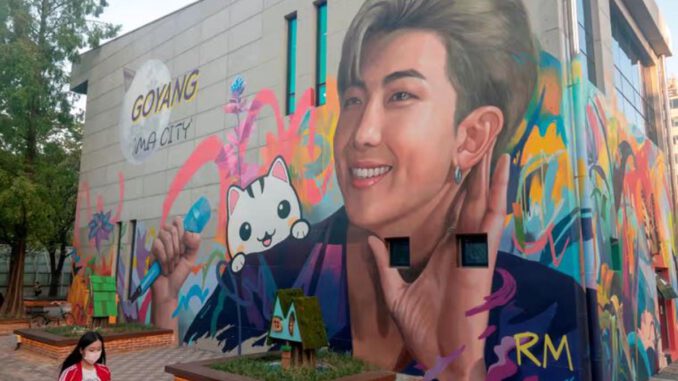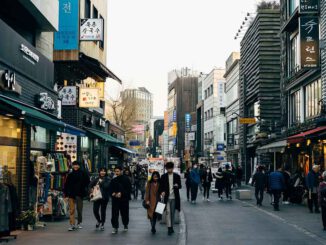
Autorin: Yvonne Heinen-FoudehFrom technology to K-fashion, from pop music to art movies and food, the world has fallen in love with everything South Korean. Insights and background on a global cultural mega trend.

The wave had started rolling with the phenomenon of Korean popular music – considered to be one of the most influential cultural movements of the 21st century. The origin for K-Pop can be rightfully attributed to Lee Soo-man: In the 80s after a brief career as a singer and DJ he went to the US to study computer engineering, returned to Seoul with the dream of globalizing Korean music. By founding SM Entertainment along with his partners they started to create a cultural universe. Instead of a worldview interpreted as a symbol or a metaphor, they created storytelling content that contains a completely „new and very attractive“ character and Lee believed that this story is an essential element for expressing artists and music. It certainly is essential element of success.
Culture before commerce
And Lee Soo-man’s dream came true. K-pop idols conquered first Asian charts, then global charts. Seoul-based rapper Psy’s Gangnam Style went viral His 2012 track video, a parody on the rich socialites living in the Gangnam area in central Seoul the first ever to break a billion views on YouTube. New members of boy bands and girl bands, aged 11 upwards, are recruited by SMCU (SM Cultural Universe) and by now other studios each year.
And as it goes with subcultures when hitting the nerve for a (re-growing) generation’s attitude to life and burgeoning resistance to social role assignment and taboos: the influence on Korean fashion trends formed the next hype.
The idols of K-Pop became fashion icons through their music and perfect dance performances. Gender-fluid looks are typical. Korean coolness sets fashion trends with looks designed for (real or virtual) stages, always created with a whole story around them.
Commitment to digital future

As of 2010 South Korean government committed to the country’s fully digital future, supported by a multibillion-dollar public-private investment fund to promote Korean creative industries and individuals. Today the nation maintains the fastest and most developed broadband network worldwide with more than 90% of households having access to high-speed internet connections.
Two sides of same coin: True-to-life simulated virtual worlds
For the good or the bad, it was that program to also heavily push technology developments, start-up initiatives for all kind of virtual interactivity, while diluting the boundary between the real and Metaverse-like gamification worlds: More and more individuals of Korean society escaping into parallel worlds to an ongoing and wide extent in the interim had been recognized as alarming.

On the credit side of the Korean boost to tech development: congenial 3D simulations of even moving images, with absolutely realistic true-to-life renderings and AI-based plug-in options to virtual presentations incl. augmented reality address exactly the needs of the consumer goods industry and thus in particular of the fashion industry on the journey to digital transformation – in product development as well as multi-channel marketing. 3D platforms with all their features available and in the pipeline, maintained out of Korea, are thus opening up completely new dimensions and worlds.
[See also relating article in this issue: z-emotion – New kid around the (European) block]
Background lecture
Korean-American journalist Euny Hong’s book “The Birth of Korean Cool – How One Country Is Conquering the World Through Pop Culture” – published by Simon & Schuster out of the UK.
Illustrated book to the unfortunately already ended special exhibition at the Victoria and Albert Museum, London: Hallyu! The Korean Wave.
Despite the ban on all outside media, K-pop tracks seem to have found their way as well to North Korea via CDs and hard drives smuggled across the border. Not least because of rumors that caught smugglers of ’subversive‘ South Korean cultural artefacts were executed by the Pyongyang regime, an export not recommended for imitation.
In the past decade, Korean cinema experienced its breakthrough in the Western hemisphere, received admiration of an international audience also at film festivals in Europe and the US. Movies from “Parasite“, “Train to Busan” or “Burning and Decision to Leave” captivated the international cinema and streaming audience.
2023 is racking up to be another great year for K-content fans. Standing out to our opinion is “Return to Seoul” among new productions, exploring the lives of Korean women from across the globe. We especially want to recommend to our readers a film set to launch in Europe in September of this year, which we had the pleasure of enjoying in a preview: “Past Lives”, directed by Celine SongThe plot: When Nora’s (Greta Lee) family moves to Canada from South Korea, she drifts apart from her childhood best friend Hae Sung (Teo Yoo). Two decades later, fate plays cupid, and the duo are able to reunite for a week in New York, US. Will this chance encounter bring up all their long-buried feelings for each other?
The title of the movie refers to the Korean belief in past lives, summarized with all its facettes under the term “In-Yun” and with the story spinning around that providing an understanding of the emotional world and attitude to life by Korean people.
Cast: Greta Lee, Teo Yoo, John Magaro, Moon Seung-ah




